7 May 2015
Downfall of Favorites
Round 1 Review of the Russian Club Championship by GM Sergei Shipov.
The tournament afforded us some pleasant surprises even before it started. It was a pleasure seeing the name of Vladimir Kramnik on the list of its participants. We haven’t seen the stars of such magnitude in the Club Championship for quite some time. I hope that others will follow this encouraging example and the future tournaments will allow us to see yet more missing elite players joining us.
It is also gratifying to see the expansion of the circle of favorites. The line-up of the Siberia leaves no doubt as to the belligerent attitude of the team. It was already in round one that this team staked out a serious claim for the overall victory by defeating the traditional tournament favorite Malachite.
However, the win did not come easy...
The stellar newcomer faced his historical rival but failed to hold out.
Shirov – Kramnik
The rivalry of these two players has presented an ever-increasing interest since 1990s. Shirov has long been known to chess fans as an excellent attacking player. To my mind, he looks even more compelling (if compared to other chess heavyweights) in complex technical endings. For example, he has outplayed Kramnik, whose technical skills are beyond any doubt, more than one time in positions with limited material. Here comes another success.
1.e4 e5 2.Nf3 Nc6 3.Bb5 Nf6 4.0–0 Nxe4 5.Re1 Nd6 6.Nxe5 Be7 7.Bf1 Nf5 8.Nf3 d5 9.d4 0–0 10.c3 Re8 11.Bd3 Bd6 12.Rxe8 Qxe8 13.Qc2 g6 14.Nbd2 b6 15.Nf1 Bd7 16.Bg5 Qf8 17.Re1 f6 18.Bd2 Re8 19.Ne3

Black’s position is safe, it is only necessary to protect the d5-pawn.
19...Nce7
It is a try to kill two birds with the same stone. Not only does Vladimir protect the pawn, but he also intends to trade the light-squared bishops on f5. This idea is not without fault, however... A lot simpler is 19...Nxe3!, without losing a tempo. Black has comfortable play, whichever way White is going to recapture on e3. For example, 20.Bxe3 Qf7 21.a3 Na5!. Or 20.fxe3 Qf7 21.e4?! (or 21.c4 Nb4 22.Bxb4 Bxb4 23.Re2 c6=+) 21...dxe4 22.Bxe4 Qxa2!=+.
20.c4! dxc4?!
Though this decision is comprehensible from the psychological point of view as the black knight strives to occupy the d5-square, it has its downsides as well. Black should have fortified the key-square by playing 20...c6 or 20...Nxe3 21.fxe3 c6.
21.Nxc4!
Now the position opens up and sharp play ensues. Upon exchange on d6 White is going to enjoy the two bishop pair advantage.
21...Nd5 22.Be4 Qf7
22...Be6 runs into 23.Qa4 with a double attack on a7 and e8... However, after 23...Re7 the pawn is untouchable as 24.Qxa7? is met with 24...c6 25.Qa6 Nc7!, when the с4-knight is lost. In this case, apparently, White would have launched a massive assault on both flanks as follows: 24.g4 Ng7 25.Nxd6 cxd6 26.h3 (also good is 26.Qc6!? Rc7 27.Qb5) 26...f5 27.gxf5 gxf5 (27...Nxf5 28.Ng5!) 28.Bd3 Nf6 29.Kh2 with small but stable pressure.
23.Nxd6 Nxd6
Kramnik sacrificed a pawn in the hope of setting up a light-squared blockade, obviously failing to evaluate every nuance of the arising position. In the case of 23...cxd6 White can build up pressure in a gradual manner. As a first step White can create a bolthole for the king and then transfer the queen to a3 to exert pressure on the weak d6-pawn.
24.Bxd5 Qxd5 25.Qxc7
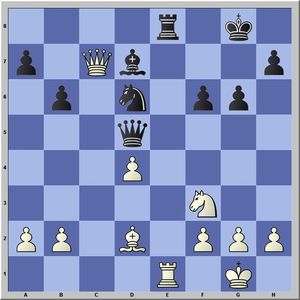
25...Nb5
25...Nf5! would have been more precise, to my mind, as it keeps the white queen out of the black king’s way. Then possible would have been 26.Rxe8+ Bxe8 27.Qb8 (27.Qxa7 Nxd4) 27...Qd7 28.d5 (28.h3 Ne7 29.Bh6 Kf7!) 28...Ne7 29.d6 Nc6 30.Qc7 Kf7 31.Bc3 Ke6, and White’s win is rather questionable.
26.Rxe8+ Bxe8 27.Qe7! Qf7 28.Qd8
Now it has become difficult for Black to maintain coordination of his pieces.
28...Nc7 (28...Kg7 29.Bf4!) 29.Bh6 Nd5
The following continuation vividly proves that the activity along the dark squares outweighs that on the light squares: 29...Ne6 30.Qb8 Qd7 31.h3 Nd8 32.h4! Nc6 (32...Ne6 33.d5) 33.Qf4 Qf7 34.Nd2!, when the knight strives to e4 to force new weaknesses in Black’s camp.
30.Qd6
The idea of knight activating via 30.Nd2 suggested itself, but after 30...Qe6 31.h3 Kf7! 32.Nc4 Qd7 33.Qb8 Ke6!, etc., Black manages to set up the defensive lines with his king in the center.
30...Ne7
30...Qd7? is impossible because of 31.Qf8#.
31.g4! Nc8
After 31...Nc6 Black is not worried about 32.d5 Qe7!, but rather about 32.g5! with active play.
32.Qd8 Qe6! 33.h3 Nd6

The knight transfer to f7 releases the stranglehold tightened over the black king, but other problems keep persisting.
34.d5! Nf7 (34...Qxd5? 35.Qe7+-) 35.dxe6
Apparently, not enough for success is 35.Qb8 Qe4 36.d6 Qe6 37.Nd4 Qe5 38.Be3 Nxd6 39.Qxa7 b5 40.b3 h5!, when Black keeps reasonable chances to escape with a draw.
35...Nxd8
The e6-pawn is a pivot point of the fight that follows.
36.Nd4 a6
Such tricks as 36...Ba4!? 37.b3 Nc6, are difficult to be found in the time trouble.
37.f4 Nc6 38.Ne2 Ne7 39.Ng3
This is not the most accurate move as it is not yet clear where the e2-khight belongs. After 39.Kf2! Bc6 his choice would have been more flexible. 40.Nd4 Bd5 41.a3 Nc6 42.Nxc6 Bxc6 43.Ke3 suggested itself so as to meet 43...Bd5 with 44.f5. However, it is yet to be proved that White has a decisive advantage in this opposite-coloured bishops ending. In my initial analysis I managed to find it, but still there is no unbounded confidence... It may be that 40.Nc3! is even stronger with the idea to answer 40...Nd5 with 41.Ne4! and Black’s position is hopeless. In the case of 40...Bd5 41.Nxd5 Nxd5 42.f5 the winning advantage is evident as after 42...gxf5 43.gxf5 Ne7 44.Be3 b5 45.Bd4! Kg7 46.Kf3! Nxf5 47.Bc5 White transfers his king on d5 with complete domination.
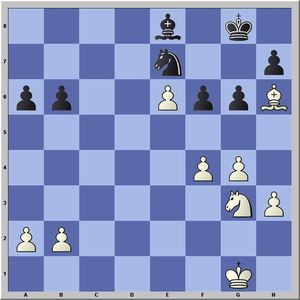
39...Bc6?!
This is the final error. Much more stubborn would have been 39...f5! in order to underline the isolated position of the e6-pawn. Does White still retain any winning chances? This is not a simple question, the answer to which was necessary to leave up to the opponent to find out.
The computer keeps insisting on the peaceful outcome of the game. Only in one line, I would say a rather extended one, did I manage to reach a winning position for White: 40.Bg5 (or 40.Kf2 Bc6 41.Bg5 – 41.Ke3 Bd5 – 41...Kf8 42.Bxe7+ Kxe7 43.gxf5 Kf6!) 40...Kf8 41.Bxe7+ Kxe7 42.gxf5 Bb5! (also bad is 42...gxf5? 43.Nxf5+ Kxe6 44.Ng7+; as well as 42...Kf6 43.Ne4+ Ke7 44.Ng5! h6 45.fxg6!) 43.Kf2 Bd3 (43...Kf6 44.Ke3 gxf5 45.e7!) 44.fxg6 (but not 44.Ke3 Bxf5! 45.Nxf5+ gxf5 46.Kd4 Kxe6=) 44...hxg6 45.f5! gxf5 46.Ke3 Bb1 47.a3 Kxe6 48.Kf4 Kf6 49.h4 Kg6 (or 49...Bc2 50.h5 Bb1 51.h6 Bc2 52.h7!) 50.h5+ Kh6 51.Nxf5+ Kxh5 52.Ne3 Ba2 53.Ke5 Bb3 (53...Kg5 54.Nd5 b5 55.Nb4) 54.Kd4 Kg5 55.Nd5 b5 56.Kc5+-).
40.f5 gxf5 41.gxf5
Now it is all over as the black king is stuck in a vice-like grip, while his white counterpart relentlessly advances forward.
41...Bb5 42.Ne4 Nxf5 43.Nxf6+ Kh8 44.Bf8 a5 45.Kf2 Bc6 46.e7 Nd6 47.Kg3 Ne8 48.Ng4 h5 49.Ne5 Bd5 50.a3 Kg8 51.Kf4 Bb3 52.Kg5 Bd1 53.Nc4 Kf7 54.Nxb6 Nd6 55.Nd5 Ne4+ 56.Kh4 a4 57.Nc3 Nxc3 58.bxc3 Be2 59.Kg5 Ke8 60.h4 Kd7 61.Kf6 Bc4 62.Bh6 Ke8 63.Bf4 Bf7 64.Bg5 Bb3 65.Ke5 Kd7 66.Kd4 Bf7 67.Kc5 Kc7 68.c4 Be8 69.Kd5 Kd7 70.c5 Bg6 71.c6+ Kc7 72.Bf4+ Kc8 73.Ke6 Bf7+ 74.Kf6 Be8 75.c7 Kd7 76.Kg7 Black resigns.
The defeated colleague was revenged by his Siberia teammates on boards two and five, thus finalizing the win with the narrowest of margins.
Aronian – Motylev

White is better, but with precise defensive play Black is supposed to hold the balance.
31...e5?
This move appears to be inaccurate. Fixing the pawn structure is like playing into the hands of White, especially his cavalry. Any waiting move would have been better. In my analysis I have failed to come up with a winning plan for White.
32.f5!
Now besides the weakness on b6 there appears a second one on f6.
32...Kd6 33.Nc3?!
This is a nearly invisible inaccuracy. More accurate is 33.g4! If Black resorts to a waiting strategy, then White has a clear winning plan: 33...Bg2 (33...e4 34.d4! cxd4+ 35.Nxd4 Ne5 36.Nxb6 Nxg4+ 37.Ke2+-) 34.Nc3 Bb7 35.Ne4+ Ke7 36.Kf3! (it is essential to recapture on e4 with the king) 36...Kf7 37.Ne3 Ba8 (after 37...Bxe4+ 38.Kxe4 the white king will occupy the d5 square) 38.Nd5 Kg7 (or 38...Bxd5 39.cxd5 Ke7 40.d6+!) 39.Ke3
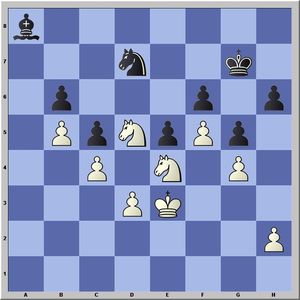
This is a zugzwang position. After 39...Kf7 40.Nc7! Bxe4 (40...Bb7 41.Nd6+) 41.Kxe4 Ke7 42.Kd5 White is winning.
33...Bg2
Black misses his chance. He should not have hesitated about the breakthrough 33...e4! Fruitless is 34.dxe4 Ne5 35.Na3 Ng4+ with subsequent recapture on h2. There is also nothing special after 34.d4 cxd4+ 35.Kxd4 (35.Nxd4? Ne5) 35...Ne5 36.Na4 Kc7 37.h3 h5=. The main continuation is 34.Nxe4+ Ke5 35.g4 Bxe4! 36.dxe4 Kd6!
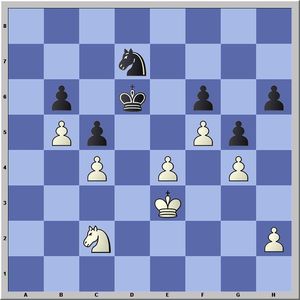
37.h3 (in the case of 37.Ke2 Ke5 38.Kf3 Kd6 39.Ne3 Ke5! 40.Nc2 Kd6 and this tango is going to last forever) 37...Ne5 38.Na3 Kd7 39.Kd2 Kd6 40.Kc3 Nf3! 41.Nc2 Ng1 42.Ne3 Nxh3 43.Nd5 Nf2 44.Nxf6 Ke5 45.Nd7+ Kd6 46.Nxb6 Nxe4+, and then Black inevitably captures on g4 and escapes with a draw.
34.Kd2
A lot tougher is 34.Ne4+! Ke7 35.g4, and White manages to eventually exchange the infiltrated bishop. For example, 35...Bh1 36.Ne1 Kf7 37.Nf3 Bg2 38.Nfd2 Ke7 39.Kf2 Bh1 40.Kg1+-.
The breakthrough 35...Bh3 36.Kf3 Bf1 37.Nf2 e4+ 38.Kxe4 Bg2+ 39.Ke3 Ne5 does not help as his piece activity is of temporary nature. White transfers the king to с3, carries out the d3-d4 advance and wins.
34...Bf3
Even now 34...e4! was still on the agenda with reasonable drawing chances, but I drop the detailed analysis.
35.Ne3
Of course not 35.Ne4+? Bxe4 36.dxe4 h5 37.Ne3 Ke7 38.Nd5+ Kf7, when Black manages to build an impregnable fortress.

Now 35...e4! was simply a must. It can be followed up with 36.Nxe4+ (in the case of 36.dxe4 h5 37.Ned5 Bg2! when the weaknesses on e4 and c4 as a minimum impede White’s progress to success) 36...Ke5 37.Nc3 h5, and I spent a lot of time analyzing this ending but failed to arrive at any unambiguous conclusion.
Yet another time Alexander did not trust his instincts and was hesitant about the breakthrough.
35...h5? 36.Ned5 Bxd5
Now 36...e4 is already late due to 37.Ke3! Bh1 38.dxe4 Ke5 39.Ne7! Kd6 40.Ncd5, and the b6-pawn is falling.
37.Nxd5 e4
In this situation this move is even more overdue than before. It’s all in the timing...
38.dxe4 Ke5 39.Ke3 Kd6 40.h4! Ke5
Or 40...gxh4 41.gxh4 Ke5 42.Nf4+-.
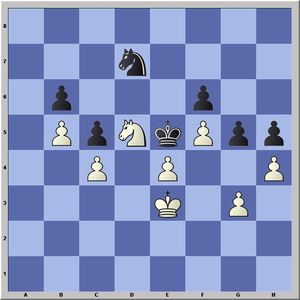
41.g4!
This breakthrough allows White to create the passed pawn on the h-file, which decides the outcome of the game.
41...gxh4 42.gxh5 h3 43.Kf2 Kxe4 44.h6 Nf8 45.Nxb6 Kxf5 46.Nd7! Black resigns.
Riazantsev – Korobov
It looks like one of the coaches of the Russian women’s chess team has not completely recovered from hard work and anxieties of the World Team Championship that has recently finished in China.
1.d4 Nf6 2.c4 e6 3.Nf3 b6 4.g3 Bb7 5.Bg2 Be7 6.Nc3 Ne4 7.Bd2 Bf6 8.0–0 0–0 9.Rc1 d6 10.d5 Nxd2 11.Qxd2 e5 12.h4 Nd7 13.Bh3 a5 14. e4 Nc5 15.Ne1 Bc8 16.Bxc8 Qxc8 17.Kh2 g6 18.Nd3 Bg7 19.Nxc5 bxc5 20.Kg2 f5 21.f3
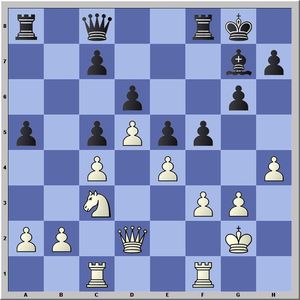
One can be easily taken in by the seeming equality of the position. Black’s play is much easier as he has a clear-cut plan of the kingside attack.
21...h5!
This move is aimed at preparing the f5-f4 advance in order to rupture the chain of white pawns. The immediate 21...f4? is answered with 22.g4!
22.Rf2
The simplifications fail to bring White any relief due to specific reasons: 22.exf5 gxf5 23.Qg5 Qe8 24.g4 Kh7! 25.Qxh5+ Qxh5 26.gxh5 Bh6 27.Rc2 Rg8+ 28.Kh3 Be3, which allows Black to build up a serious initiative. Or 24.Nb5 Kh7! (24...Qf7 25.g4!) 25.Nxc7 Qf7 26.Ne6 Bh6 27.g4 Rg8, when the white queen is lost.
22...Kh7
The immediate 22...f4 was also good.
23.Rh1
White would have been better off choosing another pawn structure via 23.exf5 gxf5, for example, 24.Qd3 Qe8 25.Rg1 Qg6 26.Kh1 Bh6 27.Rfg2 Rf7 and it would have been very difficult to break through such powerful defensive lines.
23...Bh6 24.Qd3 f4! 25.gxf4 Rxf4 26.Ne2 Rf7 27.Ng1
This road leads nowhere.
27...Qd7 28.Rh3?
Sasha is too focused on the narrow area of the struggle. He should have urgently returned his knight to active life via 28.Ne2!, and, for example, in the case of 28...Qa4 29.Nc3 Qb4 30.Nb5 a4 31.Qc3 White managed to secure transition into an acceptable ending. Probably Black would have to seek breakthrough chances on the kingside, but that could have resulted in a double-edged play.

28...Qa4! 29.b3
The 29.a3 Rb8 continuation would result in the b2-pawn becoming irreparably weak.
29...Qa3
Now the undermining advance a5-a4 cannot be stopped. White’s problems keep piling up as the foothold for black pieces becomes larger. Riazantsev tries to drastically change the picture of the struggle, but fails to achieve a great deal of success.
30.f4? Rxf4 31.Rxf4 Bxf4 32.Rf3 Qxa2+ 33.Rf2 Qa1 34.Nh3 a4!, and Black soon gained the upper hand.
The second annual contender for the overall victory in the tournament SHSM (Moscow) also fell victim to all-aged “students” from Belorechensk . The overall result depended a lot on the outcome of their leaders’ game.
Wojtaszek – Nepomniachtchi
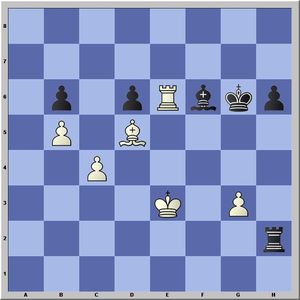
Black is very close to equality and only had to make a couple of precise moves, namely: 48...Kf5! 49.Rxd6 Be7 when the bishop occupies the с5-square to stifle every practical counterplay. However, there followed a careless
48...Kg5?
Now instead of 49.Rxd6? (which was intended to be met with 49...Be7!) Radoslaw opted for
49.Be4!
and it turned out that Black cannot hold on to the d6-pawn because after 49...Be5 50.Rg6 + Kh5 51.Rg8, there is no protection against Be4-f3. The attacked pawn has to be surrendered.
49...Rb2 50.Rxd6 Rb3+
Now in the case of 50...Be7 51.Rg6+! Kh5 52.Kf3 black king is trapped in the mating net, which necessitates sacrificing other material to get out of it.
51.Bd3 Be7 52.Rg6+ Kh5 53.Re6
Even with the white bishop pinned Black ends up with a lost position.
53...Bd8
For the sake of getting the opponent’s king mated the fate of the bishop can be neglected. 53...Bc5+ 54.Kf4! Rxd3 55.g4+ Kh4 56.Rxh6#.
54.Rd6 Be7
This time after 54...Bc7 55.Rc6 Bd8 56.Kf4 Bg5+ 57.Ke4 Bd8 58.Rd6 Bc7 it is the fate of the rook that can be neglected in view of: 59.Kf5! Bxd6 60.Be2+.
55.Rd7 Bg5+ (55...Bc5+ 56.Kf4) 56.Kf3 Ra3
Or 56...Bc1 57.Rd5+ Bg5 58.Kg2 and 59.Kh3.
57.Rd6 Be7 58.Rd5+ Bg5 59.Kg2 Ra1

Black uses every reserve to save his king. However, the second weakness in the form of a passed pawn cannot be controlled.
60.c5! bxc5 61.b6 Black resigns.
The dramatic encounter on board three has finally tilted the scale in favor of University.
Jobava – Zvjaginsev
1.c4 e5 2.Nc3 Bb4 3.e4 Nf6 4.Bd3 0–0 5.Nge2 Bc5 6.0–0 a6 7.Bc2 Nc6 8.h3 b5 9.d3 bxc4 10.dxc4 h6 11.Rb1 Rb8 12.a3 a5 13.Bd2 d6 14.Nd5 Bd7 15.Bc3 Ra8 16.Kh1 Nh7 17.b4 axb4 18.axb4 Ba7 19.Qd3
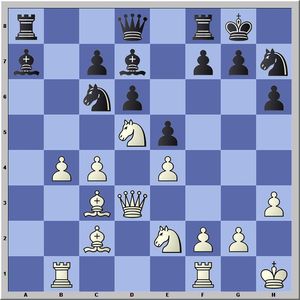
Black is to hurry with his counterplay or otherwise after the pawn break f2-f4 he will stand worse on both sides of the board.
19...f5! 20.c5
White demonstrates nice, vivid and imaginative performance. It is always a pleasure to cut off the opponent’s bishop from the game, even for a limited period of time. However, the planned 20.f4! advance is objectively better
20...dxc5 21.bxc5 fxe4
Of course not 21...Bxc5? in view of 22.Qc4 Bd6 23.Ne7+ Kh8 24.Ng6#.
22.Qe3?!
This is pursuing the same idea of muzzling the a7-bishop. This idea is not as strong as it may seem. Stronger is 22.Qxe4 Ng5, and here besides the retreat to e3 (not an easy one, by the way: 23.Qe3 Bxh3 24.Bb3! Be6 25.Rbd1 with subsequent f2-f4) there is also a sharper line with 23.Qg6! Be8 24.Qd3 Bf7 25.Rfd1! (the point is that in the case of 25.Rbd1 Bxc5! 26.f4 Bxd5 27.Qxd5+ Qxd5 28.Rxd5 Bd6 the f4-pawn is pinned) 25...Bxc5 26.f4! exf4 27.Nexf4
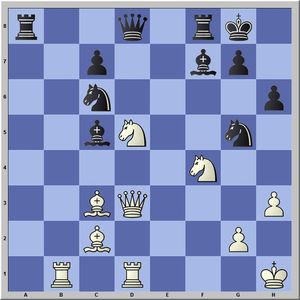
This situation does not allow Black to fend off the threat either of bishop taking on g7 or the h2-h4 stab. For example, 27...Rc8 (a random move made just for the sake of demonstrating an idea) 28.Bxg7 Kxg7 29.Qc3+ Bd4 30.Rxd4 Ne5 31.Rd2 Qd6 32.Ne3 Qf6 33.Rf2 Kg8 34.Nfd5 Qxf2 35.Ne7+ Kg7 36.Qxe5+ Qf6 37.N3f5+ and White is winning.
22...Ng5 23.Rfd1
The chess program is slow to understand that after 23.Rbd1 Bxh3! White faces serious problems. Omitting the details I am just going to say that the strongest here is 24.f4!! exf3 25.gxh3 fxe2 26.Qxe2, when White’s activity along the light squares is good enough to equalize. For example, 26...Rxf1+ 27.Qxf1 Nd4 28.Qc4 Kh8 29.Rxd4 exd4 30.Nf4 dxc3 31.Ng6+ with perpetual check.
23...Bxh3!

This is a strong blow, but not a deadly one.
24.Ba4
Without the f1-rook the line with 24.f4 exf3 25.gxh3 lacked its strength in view of 25...Nxh3. Of course not good is 24.gxh3 Rf3 25.Qd2 Nxh3 26.Bxe4 Nxf2+ 27.Kg2 Nxe4–+. 24.Bb3 Kh7! fails to solve White’s problems either. Probably the best continuation is 24.Nb4 Qf6 (or 24...Qc8 25.Nxc6 Bxg2+ 26.Kxg2 Bxc5 27.Ne7+!) 25.gxh3 Bxc5 26.Qg3 Bxf2 27.Qg4, and the profound complications are very likely to result in a drawish outcome. For instance, 27...Nd4 28.Nd5 Qf3+ 29.Qxf3 Rxf3 30.Nxd4 Rxh3+ 31.Kg2 exd4 32.Bxd4 Bxd4 33.Rxd4 Ra2 34.Rc1 Rd3 35.Rxd3 exd3 36.Nb4 Rxc2+ 37.Nxc2 dxc2 38.Rxc2=.
24...Bd7?
This is a strange-looking decision, more in the nature of a psychological breakdown. Firstly, 24...Qc8 25.Bxc6 Bxc5! suggested itself. Of course the c5- bishop cannot be captured in view of the take on g2 with subsequent mate. In the case of 26.Ne7+ Bxe7 27.Bxa8 Qxa8 28.Bxe5 Bxg2+ 29.Kxg2 Black would successfully continue his attack even with the rook missing: 29...Rf3 30.Qd4 e3! Therefore, it is necessary to look for other defensive measures, which are luckily available via 26.Rg1!!

Looking at the computer screen I could not but say “Wow!” This move would escape me even on the fifth calculation of variations. The subsequent exchange of blows leads to White’s advantage: 26...Bxe3 27.Ne7+ Kh7 28.Nxc8 Bxf2 29.Bxa8 Bxc8 30.Rgf1 Bg4 31.Rxf2 Rxf2 32.Ng3 when Black cannot feel happy about the formal material equality.
Therefore, the sequence of initial moves needs to be reconsidered as follows: 24...Bxc5!! 25.Qxc5 Qc8!, and now White is very unlikely to hold his position together. For instance, 26.Kg1 Bxg2 27.Ne7+ Nxe7 28.Qxe7 Qh3-+.
Or 26.Ng1 Bxg2+ 27.Kxg2 Qg4+ 28.Kf1 e3! 29.Qxe3 Rxa4 30.Qe2 Qh4! 31.Rd3 Rg4 and Black is going to follow up with pushing his pawn to e3 and, perhaps, placing his rook on f3. I failed to find any satisfactory defense for White.
So, in this way Zvjaginsev could have defeated his opponent and lead his team to the overall victory in the match (given also that Dubov defeated Alekseev on board five). This missed opportunity, however, has left this world and belongs now to some other universe.
In our universe Black's passive move was followed up with
25.Nb6! Bxb6 26.Bxc6 Bxc5 27.Qxc5 Ne6 28.Bd5 Qh4+ 29.Kg1 Kh8 30.Bxe6 Bxe6 31.Bxe5, and Black had to resign.
The distinguished Kazan lost to Lada in a football style. The team failed to capitalize on the opportunities that presented themselves.
Artemiev – Bukavshin
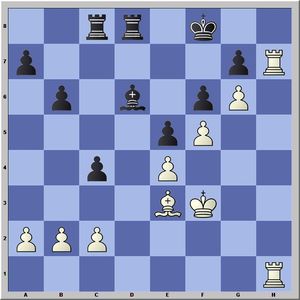
Vladislav has completely outplayed the newly-crowned U21 Russian Champion and needed only to put an effective period to the whole story. In fact, White has a clear and simple win at his disposal: 32.Bh6! gxh6 (32...Rc7 33.Rh8+ Ke7 34.Bxg7+-) 33.R1xh6 Bc7 (33...Rc7 34.Rh8+ Ke7 35.R6h7#) 34.Kg4!, and Black is completely helpless: 34...b5 35.Kh5 Bb6 36.g7+ Kf7 37.g8Q+! Kxg8 38.Kg6! Kf8 39.Rg7, with inevitable mate.
I believe that young, promising players, which are counted on by the coaches and fans of our team, should not fail to find such combinations.
There followed, however
32.Rh8+ Ke7 33.R8h7 Rg8!
Ivan, on the other hand, had seen the bishop lunge 32.Bh6!, and, therefore, avoided returning to the initial position.
34.Bh6 Kf8 35.Rd1!
Nevertheless, the White bishop finally offered himself to be taken on h6.
35...Rc6
35...Rd8 was not a saver either in view of 36.Kg4! Bc7 (36...gxh6 37.Kh5+-) 37.Rxd8+ Bxd8 38.Kh5! Be7 39.Bxg7+ Rxg7 40.Kh6! Rg8 41.Rf7+ Ke8 42.Kh7, when the g6-pawn decides the fate of the game.
36.Be3?
How? What for?? It was essential to keep putting further pressure on the opponent’s weak point as far as it would go: 36.Kg4! b5 (or 36...gxh6 37.Rf7+ Ke8 38.Rxf6+-) 37.Kh5 a6 (for lack of any constructive ideas) 38.Bxg7+ Rxg7 39.Kh6+-.
36...Ke8! 37.Rd5
It is already impossible to return to the previous plan: 37.Bh6 Bf8! 38.a4 Rc7 39.Rd5 (39.Bg5 Be7!) 39...Rd7, and Black manages to keep his position from falling apart.
37...Be7! 38.a4 Rd6
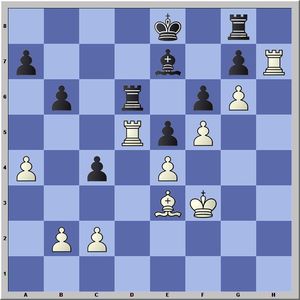
39.Rxd6
Played in a very dull style yet another time. The last chance to hurt the opponent was by playing 39.a5! with the idea 39...Rxd5 40.exd5 bxa5 41.Rh4!
39...Bxd6 40.Ke2
This time 40.a5 is answered with a simple 40...bxa5! 41.Bxa7 Kd7=.
40...Kd7 41.Bh6 Bf8 42.Bd2 Bd6
Black has successfully covered both his flanks, and in the game that ensued Artemiev failed to overwhelm the defence of his tough opponent.
43.Rh3 Rc8 44.b3 Kc6 45.bxc4 a5 46.Rh7 Rg8 47.Be1 Bc5 48.Rh3 Rd8 49.c3 Re8 50.Kd3 Rd8+ 51.Kc2 Re8 52.Bd2 Rd8 53.Bc1 Re8 54.Kb3 Rd8 55.Rh7 Rg8 56.Ba3 Kc7 57.Rh1 Kc6 58.Bxc5 bxc5 59.Kc2 Draw.
When you fail to score you get scored on, as the football saying goes. Sjugirov and Predke got the upper hand against Kamsky and Makhmutov respectively. The overall result of the match is 4-2 in favour of Lada.
There was no real fight in the confrontation between Yamal and Bronze Horseman. The final score 0-6 fails to reflect the intensity of the struggle on separate boards, but the difference in class was of course quite evident.
The tournament has demonstrated its fighting spirit right from the start as not even a single match was drawn. Let blood be drawn even further!






















